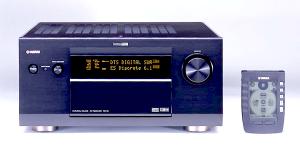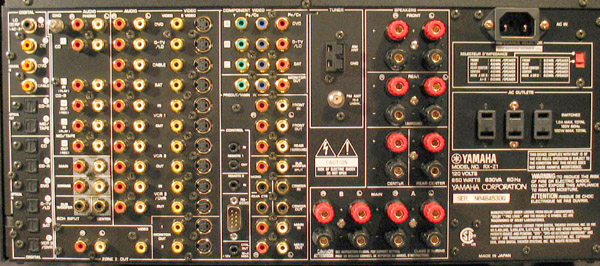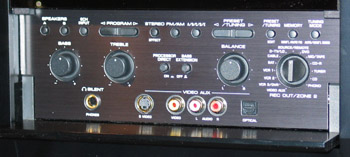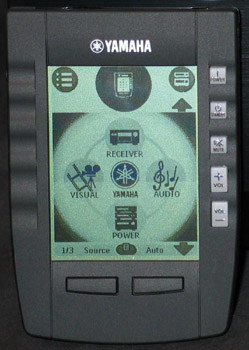|
|||||||||
|
Introduction Yamaha has been in the AV Receiver business for as long as most of us can remember there being such a business. In the Pro Logic hey day, Yamaha was offering equal power to the front three channels when others were still shortchanging us with as little as 10 watts to the center speaker. They were among the first to do Pro Logic decoding in the digital domain, setting a precedent for the analog to digital to analog path which is so critical, even today. We at Secrets have always had confidence in Yamaha receivers, at very least from the power amp perspective. The units have always been well built and able to drive a decent amount of current through a speaker. The Design The RX-Z1 is of course one of those statement piece type receivers, the kind for which the very name "receiver" is an insult. It's like calling a Lexus a "Mobile CD Player". The Fed Ex man wheeled it in, along with the RX-V640, on a dolly. "There's some weight to that bottom one", he declared. No kidding. When we opened it up, we found something I've never seen in any hi-fi component box: The RX-Z1 was covered in a thin sort of linen sheet which included an elastic waist to cinch it at the underside. Though probably worth just $0.10, its an awfully nice touch, giving the person who just dropped the hefty $3K a little more pride. In terms of I/O, the Z1 is impressive with its 11 stereo inputs (7 with video), which includes a phono input, and 9 digital inputs (3 coax, 6 optical) plus one old fashioned AC-3 RF input for Dolby Digital-capable Laserdisc Players. All the digital inputs are re-assignable. Three Component video lines, a pair of optical digital outputs and a 5.1 analog input are all there. Although this is not the sort of unit you would buy and then immediately connect an outboard power amplifier to it, pre outs for all channels are provided, with the front three channels being capable of pre-main coupling.
IR in/outs, a 12V trigger, antenna terminals, and an RS-232 port for external control round out the back panel. After all that, we were disappointed to see the RX-Z1 has only one line-out and speaker out for the center surround (a.k.a. rear) channel. Although Dolby does not expressly require it, in our listening experience, two speakers are a must. True, you can run a pair of speakers in parallel, showing the Z1 as much as 16 ohms (not an problem), but if Yamaha had gone with two amps instead of one, they could have done some interesting things like provide a choice of where to route the surrounds of a 5.1 source, i.e., to the sides, rears, or both. Instead, the Z1 gives us "Front Effects" speakers. Yamaha has for decades now been doing what they call DSP and/or Cinema DSP (Digital Soundfield Processing). This was one of the first systems to "simulate" various acoustic environments like the echo of a cathedral or the immediacy of a jazz club by applying a complex mix of reverb/decay algorithms, developed using acoustic data from actual venues. While the system uses the surround speakers for both the surround channel and DSP reflections at the rear, the "front effect" speakers are used to separate, and indeed elevate, the DSP's front reflections above the normal front channel speakers (if you don't have an extra set of speakers, the front reflection sounds will just be mixed into the main left and right). I (Brian) for many years was the proud owner of several Yamaha receivers, all of which had Cinema DSP. It is fun to once and a while pipe some Mozart through the Concert Hall mode, but the Movie modes just don't "work". To understand why this is so, you have to first understand what exactly CinemaDSP is doing. Like the music venues, CinemaDSP takes the decoded soundtrack and simulates the reflections found in a large movie theater (and from what it ends up sounding like, an acoustically live one). Literally, a sound which is in the right surround channel, for example, can be heard a fraction of a second later from the left surround, and to a lesser extent the left front, and to an even lesser extent the right front. If you use the test "clicks" on AVIA, made specifically for this purpose, it really does sound like you are in a highly reflective room. Where CinemaDSP falls apart completely is with dialog. It would compromise intelligibility, not to mention sound down right stupid, if a conversation was being bounced all over the place. For this reason the center channel has no DSP applied to it whatsoever. Although that seems like it would do the trick, it collapses when something, anything, is panned across the front stage. The sound will have a reverb, then suddenly come into focus as it hits the center channel. It's more distracting than if the center channel had the same reverb applied to its signal. Lately, Yamaha has been adding a new parameter to its DSP modes: Effect Gain. In the Z1 you can actually attenuate the simulated reflections, making the modes marginally more believable and useful. The Z1 build quality is absolutely exquisite. They've actually put soft adhering pads at every panel seam so that the case will not ring or resonate, a very real problem with some cheap, thin metal chassis I've seen. Getting back to the sheer weight of the beast, I judge the majority of it to be in the transformer, as when you lift it, all the weight is right there at that back corner. There is a thermally controlled fan which is not directly on the heat sink as you might think. It is strategically placed to essentially change all the air in the case by encouraging the natural up flow of hot air. For us, the fan only spun at power-on during the self check. In terms of surround decoding, the Z1 is everything you'd expect, with Pro Logic II, Dolby Digital EX, DTS ES (including 24/96), and DTS Neo:6.
The software of the Z1 is both a strength and weakness. It offers many amenities which impressed us greatly, though most of these seemed to lack follow-through (we'll explain that later). On the other hand, the User Interface is, in our learned opinion, the pits. Making adjustments or tweaking settings is a tedious, cumbersome process which is only marginally improved when connecting the Z1 to a TV for the sake of its on screen display. Although the volume is the digitally controlled analog type, Yamaha takes no advantage of it. There is no option to choose a power-on volume level, nor is there any means of selecting a max volume setting. There is no choice for dB attenuation on the mute, and inputs do not have any sort of level trim. The numbers on volume scale are totally arbitrary. It is not relative to anything other than the top of the volume's own scale (in other words, having the volume at "-20dB" means nothing). One can of course figure out what reference corresponds to, but it would have been dead simple for Yamaha to have scaled the number and allow us to set all speaker levels relative to it. [Editor's Note: All of Yamahas brand new THX AV Receivers get this right]. Each pair of speakers can be set to "Large" or "Small" (center and surrounds can also be set as "None"). The crossover is a fixed set of slopes at 90 Hz. While we don't advocate deviating far from 80 Hz, we know people want choice here and are very disappointed to see none in such an upper-end product. In addition to the basic 5 speaker setup test signals, Yamaha has included (in a separate area of the setup) a band limited rumble tone, but in our view it is impractical for subwoofer setup. It is basically a band limited pink noise tone whose center frequency can be adjusted from 35 Hz to 250 Hz. You then pick which channel you want to play it on. To set up a sub, you'd play the tone on a main channel set as Small, set the frequency to something above the crossover point (200 Hz or so), and note the SPL. You would then lower the center frequency to below the crossover point (say, 40 Hz) and set the subwoofer level to produce the same SPL. Alternatively, you could leave the tone at 40 Hz, and flip flop between the sub and a main channel set as Large (assuming your main speaker and sub have identical spectral in-room response, which they almost certainly would not). Given the tedious User Interface, you're better off just using AVIA or Video Essentials. There is an LFE trim adjustment which is common to both Dolby Digital and DTS. The trim has two values: One for when speakers are in use, and another for when headphones are in use. This sounds like a good idea, since headphones can easily be overwhelmed with bass, but when down-mixing Dolby Digital 5.1, the LFE channel is supposed to be discarded anyway. In addition, the headphones have their own DRC (Dynamic Range Control) setting. Yamaha's Cinema EQ is an interesting little notion. Its is basically two EQs: One for the front LCR array and one for the surrounds. Each consists of two parts: A low pass with selectable frequency and gain, and a parametric EQ with selectable frequency and band (the Q is fixed at 1.85). This is obviously an attempt at one upping THX's Re-Eq and timbre-matching functions but without some very expensive RTA equipment, it's not going to do you much good, not to mention how cumbersome it is to turn it on and off (deep within the setup menus). Conversely, if any channel should get an EQ, even a single band fixed Q parametric EQ, it should be the subwoofer, but that output gets nothing. There is a single AV Sync delay setting, range of 0-160ms. This is excellent. Time alignment is critical for proper operation of a multi channel audio system, yet Yamaha's software engineers seem to have completely misunderstood the point of it. Under "Speaker Delay" in the setup menu, you can choose feet, meters, or milliseconds. Normally with an SSP, you give it the distance to each speaker, and the system calculates the differences in distances and applies the appropriate delay to the various speakers. With the RX-Z1, the computer only delays the center channel from the main left/right, and the center surround from the surround left/right. The front three speakers are NOT time aligned with the two (or three) surrounds! To properly time align the system, you must engage each and every mode the system has (Dolby Digital, DTS, Pro Logic II Movie, Pro Logic II Music etc.) and one by one use the remote's "parameter" page to manually set the delay of the surrounds (in milliseconds), all the while remembering to add in 15 ms on the matrix CODECs such as Pro Logic. And oh yes, there is no way at all to time align the subwoofer. This is unfortunate for a $2,800 product. The front panel offers four levels of illumination.
We could write an entire review on this remote, but suffice it to say, with the exception of controlling the Yamaha itself, it was a joy to use. It is very easy to set up. You don't even need a table of codes to set the various brands of components you have: You can select them from an alphabetical list right on the remote's screen. If you really want to get advanced, you can download the RAV software from Yamaha's website and use the included 9 pin serial cable to get it talking to your PC. Why they did not include the software on a CD, I just don't know. Heaven forbid anything happen to your remote. Without it, you cannot use the RX-Z1. The front panel offers no access to the setup and adjustment of the unit, and uses the rotating knob concept for input selection. What you will find behind the drop down door is control of the radio, DSP mode selection (yeah, that's more important than setting the unit up . . . not!) and knobs for bass/treble and recording source selection. There are buttons for pure analog operation and "bass boost" (something I thought went our of style in the 1980s). There is also a handy input set on the front for stereo audio, optical digital audio, and composite/S-Video. The 6 channel input is a pure analogue feed. There is no option to digitize it for the sake of bass management or time alignment. There is however an option to reroute the center channel to the main left and right, and likewise for the LFE channel. The Zone2 outputs can monitor a difference source from the main zone, and the two-channel audio can be fixed level output or variable (independent of the main zone volume naturally). The Sound It's interesting to note that unlike all of Yamaha's other AV Receivers which use their own DACs, the RX-Z1 employs chips from well renowned Burr-Brown, attributing to the different, improved sound as compared to their other receivers. Indeed the sound is very natural and real, with horn sections that sound like horn sections and dialog that rings true. Yamaha quotes the power from all channels (except the "Front Effects" channels) as being 130 watts into 8 ohms, 20 Hz - 20 kHz with 0.15% THD. That's good, but they don't qualify that with a number of channels driven. In practice, though, there is PLENTY of power! With the front three speakers set to Large, we did note a shift in character at the high end when reaching irresponsible playback levels. It was not clipping, but perhaps getting near it as the treble took on a sharper, harder quality. In high passing all channels (speakers set to small, so sounds below 90 Hz went to the sub), we could not find any point at which there was any aberrations in the sound at all. High pass everything and use a proper powered subwoofer and "plenty of power" turns into "more than you are likely to ever need". Click Here to Go to Part II - On the Bench and Conclusions
|
|||||||||



 The Functions
The Functions The
RX-Z1 Remote Control is the
RAV-2000. It is a fairly light weight touch screen unit, and I can see them
including it, as only a graphic touch screen could control the Yamaha's
complex UI. Of course, the remote has extensive pages for use with the
RX-Z1, but we found the layout so tight, you need a PDA stylus to do
anything, because the buttons are very small and quite close together.
The
RX-Z1 Remote Control is the
RAV-2000. It is a fairly light weight touch screen unit, and I can see them
including it, as only a graphic touch screen could control the Yamaha's
complex UI. Of course, the remote has extensive pages for use with the
RX-Z1, but we found the layout so tight, you need a PDA stylus to do
anything, because the buttons are very small and quite close together.

